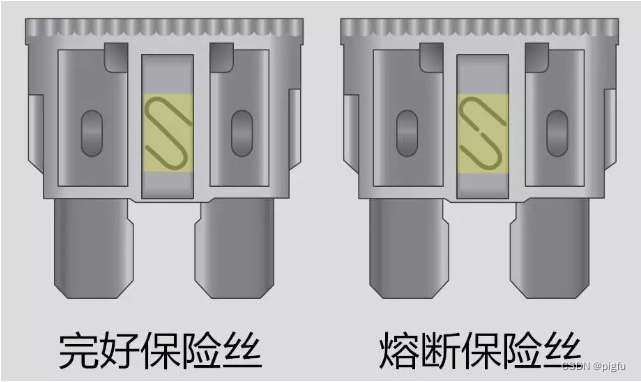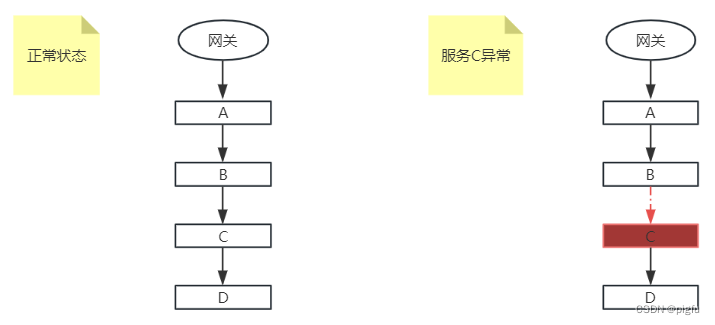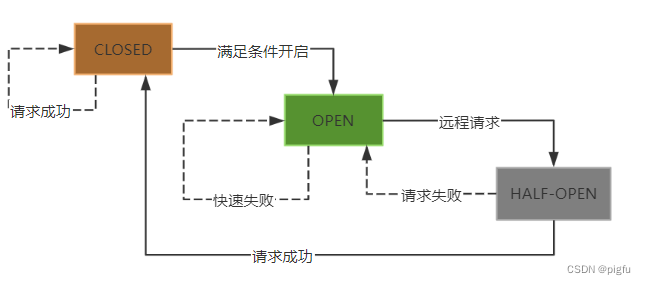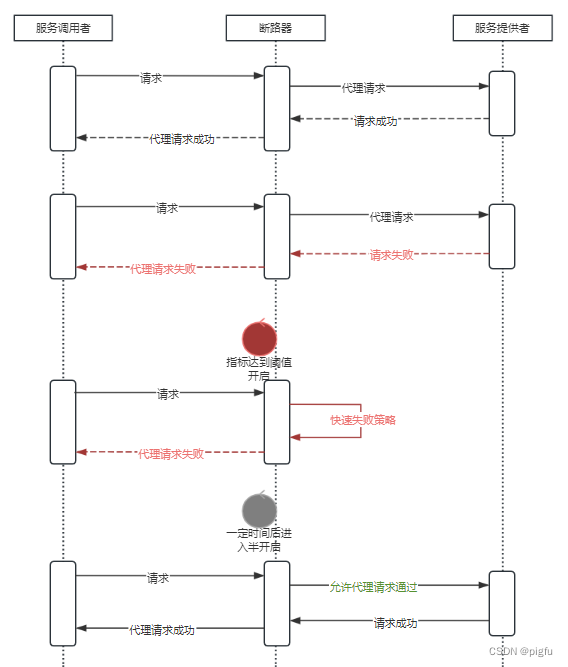文章目录
- 概要
- 一、服务熔断
- 二、断路器模式
- 三、hystrix-go
- 3.1、使用
- 3.2、源码
- 四、参考
概要
微服务先行者Martin Fowler与James Lewis在文章microservices中指出了微服务的九大特征,其中一个便是容错性设计(Design for failure)。正如文章中提到的,微服务相对于单体服务而言,不同服务之间的通信是经过网络完成的,上下游服务间调用时,下游服务可能随时处于不可用状态(比如崩溃,达到服务最大处理能力等等原因)。
由此会引发一个问题,一个服务点的错误经过层层传递,最终会波及到调用链上的所有服务,这便是雪崩效应,因此如何防止雪崩效应便是微服务架构容错性设计原则的具体实践,否则服务化程度越高,整个系统反而越不稳定。
在实践中有很多容错方案,诸如故障转移、快速失败(服务熔断)、安全失败、沉默失败、故障恢复、负载均衡、重试、限流、服务降级、舱壁隔离等等。这些方案分别从事前(负载均衡、限流、舱壁隔离、服务降级),事中(故障转移、快速失败、安全失败、沉默失败、重试),事后(故障恢复)三个节点提高整个系统的稳定性。
PS:服务降级归到事前,主要是因为服务降级大多数情况下不是在出现错误后才被执行的,在许多场景中,所说的服务降级更多的是指需要主动使服务进入降级逻辑的情况,比如电商预见双11流量高峰、游戏停服更新等。
一、服务熔断
服务熔断策略方案来源于生活中的电路保险丝,电路保险丝遵循一家一个的原则,当该家庭电流增大到一定数值时,其自身熔断而切断电路,保护电视机、冰箱等电器,并不会影响其他家庭的用电。

同理,可推理到微服务之间的网络调用。

如图,当服务C出现异常构,服务B很快会检测到服务C不可用(服务C接口超时或错误等指标满足不可用判定条件),此时服务B不在将请求转发到服务C,而是快速返回错误信息(快速失败)。在一段时间内的后续请求就一直返回失败,稍后当检测到服务C接口调用响应正常后,就会恢复到正常状态。
二、断路器模式
断路器模式是实现熔断策略的具体方案,其本质是接管微服务之间的远程调用请求,断路器会持续监控并统计被调用服务接口返回成功、失败、超时、拒绝等各种结果的指标,当某一个指标满足预设阈值时,断路器就会进入开启状态,后续相应的远程调用请求就会快速返回错误信息,而不会真的对被调用服务发起请求。若干时间后断路器会进入半打开状态,此时断路器会放行一次请求,如果请求正常,则断路器进入关闭状态,否则转入开启状态。
从上面描述来看,断路器是一种有限状态机:

- 关闭状态,此时断路器会放行请求到下游服务,该状态是断路器的初始状态;
- 开启状态,当断路器统计的某一项指标满足开启条件时就会进入该状态,此时不会放行请求到下游服务,而是快速返回错误信息;
- 半打开状态,这时一种中间状态,主要是因为断路器要具有故障恢复的能力,所以当进入该状态时,断路器会允许放行一次请求到下游服务。一般是在断路器开启后若干时间后自动进入该状态。
断路器进入半打开状态在实现时并不需要计时器,而是收到请求时检测下是否满足半打开状态(一般是将断路器开启时间与当前时间做比较),是的话就放行该次请求,否则快速返回错误信息。
断路器工作时序图如下:

三、hystrix-go
hystrix-go是作者从JAVA Netflix的子项目Hystrix翻译过来的,很经典的断路器项目。
3.1、使用
hystrix-go 调用接口有两个:
- Do:同步调用
func Do(name string, run runFunc, fallback fallbackFunc)
- Go:异步调用
func Go(name string, run runFunc, fallback fallbackFunc)
hystrix-go配置项:
// CommandConfig is used to tune circuit settings at runtime
type CommandConfig struct {Timeout int `json:"timeout"`MaxConcurrentRequests int `json:"max_concurrent_requests"`RequestVolumeThreshold int `json:"request_volume_threshold"`SleepWindow int `json:"sleep_window"`ErrorPercentThreshold int `json:"error_percent_threshold"`
}
- MaxConcurrentRequests:请求的并发量,接口并发超过该值也会被归为接口错误(ErrMaxConcurrency);
- Timeout:请求超时时间,接口响应时间超过该值也会归为接口错误(ErrTimeout);
- RequestVolumeThreshold:一个窗口(代码里写死的10秒)内的请求数阙值,达到这个阙值才会进入接口错误百分比计算逻辑;
- ErrorPercentThreshold :设置接口错误(除了ErrMaxConcurrency,ErrTimeout两种错误,接口自身错误也会被计入)的百分比,大于该值断路器就会进入开启状态;
- SleepWindow:断路器开启后,多久后进入半开启状态。
直接上代码。
import ("errors""fmt""github.com/afex/hystrix-go/hystrix""time"
)
var (global errortimes int
)
//模拟远程请求
func mockHttp() error {times++fmt.Println(times)if global != nil {return nil}time.Sleep(2 * time.Second)return errors.New("业务出错")
}
const breakFlag = "testBreaker"
func main() {hystrix.ConfigureCommand(breakFlag, hystrix.CommandConfig{Timeout: 1000, MaxConcurrentRequests: 50, ErrorPercentThreshold: 25, RequestVolumeThreshold: 4, SleepWindow: 1000, })//hystrix.SetLogger() //打印断流器内部日志for i := 0; i < 10; i++ {time.Sleep(time.Millisecond * 400) //给熔断器重试服务时机_ = hystrix.Do(breakFlag, func() error {return mockHttp()}, func(err error) error { //不发生错误不会进入该逻辑的if err != nil {fmt.Printf("times:%d,断路器检测到错误:%s\n", times, err.Error())} else {fmt.Printf("times:%d,断路器恢复正常", times)}global = errreturn nil})}fmt.Println("times:", times)
}
输出如下:
1
times:1,断路器检测到错误:hystrix: timeout
2
3
4
times:4,断路器检测到错误:hystrix: circuit open
times:4,断路器检测到错误:hystrix: circuit open
times:4,断路器检测到错误:hystrix: circuit open
5
6
7
times: 7
分析:
可以看到真正发出的请求是7次,3次是被快速失败了
- 第一次请求接口超时;
- 第四次请求时,10s内的请求4个了,满足RequestVolumeThreshold配置,此时错误接口个数是1,计算1/4*100等于25,不小于ErrorPercentThreshold配置,断路器进入开启状态;
- 第五、六、七次的请求都被快速失败了;
- 第八次请求时,满足断路器进入半开启状态的条件(time.Millisecond * 400*3>=SleepWindow),放行本次请求,并且请求响应正常,那么断路器进入关闭状态;
- 第九、十次正常。
3.2、源码
Do和Go两个API最终都会进入GoC函数
func GoC(ctx context.Context, name string, run runFuncC, fallback fallbackFuncC) chan error {cmd := &command{run: run,fallback: fallback,start: time.Now(),errChan: make(chan error, 1),finished: make(chan bool, 1),}circuit, _, err := GetCircuit(name)//获取指标统计器if err != nil {cmd.errChan <- errreturn cmd.errChan}cmd.circuit = circuitticketCond := sync.NewCond(cmd)ticketChecked := falsereturnTicket := func() {cmd.Lock()// Avoid releasing before a ticket is acquired.for !ticketChecked {ticketCond.Wait()}cmd.circuit.executorPool.Return(cmd.ticket)//执行完之后归还请求令牌cmd.Unlock()}// Shared by the following two goroutines. It ensures only the faster// goroutine runs errWithFallback() and reportAllEvent().returnOnce := &sync.Once{}reportAllEvent := func() {err := cmd.circuit.ReportEvent(cmd.events, cmd.start, cmd.runDuration)//上报此次请求时正常还是异常,便于后续进行指标统计if err != nil {log.Printf(err.Error())}}go func() {defer func() { cmd.finished <- true }()if !cmd.circuit.AllowRequest() {//统计指标,决定开启、半开启、关闭三个状态的流转cmd.Lock()// It's safe for another goroutine to go ahead releasing a nil ticket.ticketChecked = trueticketCond.Signal()cmd.Unlock()returnOnce.Do(func() {returnTicket()cmd.errorWithFallback(ctx, ErrCircuitOpen)//上报断路器处于开启状态的错误,不过该错误不会被纳入接口错误指标reportAllEvent()})return}cmd.Lock()select {case cmd.ticket = <-circuit.executorPool.Tickets://获取一个请求令牌ticketChecked = trueticketCond.Signal()cmd.Unlock()default: //没有令牌,就表示请求达到并发限制MaxConcurrentRequests配置的值,上报ErrMaxConcurrency错误ticketChecked = trueticketCond.Signal()cmd.Unlock()returnOnce.Do(func() {returnTicket()cmd.errorWithFallback(ctx, ErrMaxConcurrency)reportAllEvent()})return}runStart := time.Now()runErr := run(ctx) //没有达到限流就发起请求returnOnce.Do(func() {defer reportAllEvent()cmd.runDuration = time.Since(runStart)returnTicket()if runErr != nil {cmd.errorWithFallback(ctx, runErr) //出错就上报业务接口的错误return}cmd.reportEvent("success")//表示请求成功})}()go func() {timer := time.NewTimer(getSettings(name).Timeout)//根据Timeout配置起一个定时器defer timer.Stop()select {case <-cmd.finished: //请求执行完毕// returnOnce has been executed in another goroutinecase <-ctx.Done(): //收集context上下文错误returnOnce.Do(func() {returnTicket()cmd.errorWithFallback(ctx, ctx.Err())reportAllEvent()})returncase <-timer.C: //标识服务接口超时,上报ErrTimeout错误returnOnce.Do(func() {returnTicket()cmd.errorWithFallback(ctx, ErrTimeout)reportAllEvent()})return}}()return cmd.errChan
}
进入开启状态
func (circuit *CircuitBreaker) AllowRequest() bool {return !circuit.IsOpen() || circuit.allowSingleTest()
}
//判断断路器处于关闭状态还是开启状态
func (circuit *CircuitBreaker) IsOpen() bool {circuit.mutex.RLock()o := circuit.forceOpen || circuit.opencircuit.mutex.RUnlock()if o {return true}if uint64(circuit.metrics.Requests().Sum(time.Now())) < getSettings(circuit.Name).RequestVolumeThreshold {return false}if !circuit.metrics.IsHealthy(time.Now()) {//计算10s内错误请求百分比// too many failures, open the circuitcircuit.setOpen() //断路器状态为开启状态return true}return false
}//circuit.metrics.Requests().Sum方法,这里可以看到统计指标的窗口是10s
func (r *Number) Sum(now time.Time) float64 {sum := float64(0)r.Mutex.RLock()defer r.Mutex.RUnlock()for timestamp, bucket := range r.Buckets {// TODO: configurable rolling windowif timestamp >= now.Unix()-10 {sum += bucket.Value}}return sum
}
断路器半开启状态判断
func (circuit *CircuitBreaker) allowSingleTest() bool {circuit.mutex.RLock()defer circuit.mutex.RUnlock()now := time.Now().UnixNano()openedOrLastTestedTime := atomic.LoadInt64(&circuit.openedOrLastTestedTime)//如果断路器处于开启状态,且当前时间>断路器开启时间+SleepWindow配置,精确到纳秒,则进入半开启状态if circuit.open && now > openedOrLastTestedTime+getSettings(circuit.Name).SleepWindow.Nanoseconds() {swapped := atomic.CompareAndSwapInt64(&circuit.openedOrLastTestedTime, openedOrLastTestedTime, now)if swapped {log.Printf("hystrix-go: allowing single test to possibly close circuit %v", circuit.Name)}return swapped}return false
}
恢复为关闭状态
func (circuit *CircuitBreaker) ReportEvent(eventTypes []string, start time.Time, runDuration time.Duration) error {if len(eventTypes) == 0 {return fmt.Errorf("no event types sent for metrics")}circuit.mutex.RLock()o := circuit.opencircuit.mutex.RUnlock()if eventTypes[0] == "success" && o {//此次请求成功,且断路器处于开启状态,则将断路器转为关闭状态circuit.setClose()}//省略代码...return nil
}
四、参考
1]:服务治理:熔断器介绍以及hystrix-go的使用
2]:Microservices













)

)

认证题库)

)